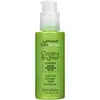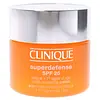What's inside
What's inside
 Key Ingredients
Key Ingredients

 Benefits
Benefits

 Concerns
Concerns

 Ingredients Side-by-side
Ingredients Side-by-side

Butyl Methoxydibenzoylmethane 3%
UV AbsorberHomosalate 5%
Skin ConditioningEthylhexyl Salicylate 5%
UV AbsorberOctocrylene 7%
UV AbsorberWater
Skin ConditioningGlycerin
HumectantSilica
AbrasiveDimethicone
EmollientPEG-100 Stearate
Glyceryl Stearate
EmollientAmmonium Polyacryloyldimethyl Taurate
Emulsion StabilisingAscorbyl Glucoside
AntioxidantBenzyl Alcohol
PerfumingBenzyl Salicylate
PerfumingButylene Glycol
HumectantCapryloyl Salicylic Acid
ExfoliatingCaprylyl Glycol
EmollientCitral
PerfumingDicaprylyl Carbonate
EmollientDimethicone/Vinyl Dimethicone Crosspolymer
Skin ConditioningDipropylene Glycol
HumectantDisodium EDTA
Parfum
MaskingGeraniol
PerfumingLimonene
PerfumingLinalool
PerfumingMyristic Acid
CleansingNymphaea Alba Flower Extract
Skin ConditioningPalmitic Acid
EmollientPhenoxyethanol
PreservativePhenylethyl Resorcinol
AntioxidantSodium Hyaluronate
HumectantSodium Hydroxide
BufferingSodium Palmitoyl Proline
Skin ConditioningSteareth-100
Gel FormingStearic Acid
CleansingT-Butyl Alcohol
PerfumingTocopherol
AntioxidantXanthan Gum
EmulsifyingButyl Methoxydibenzoylmethane 3%, Homosalate 5%, Ethylhexyl Salicylate 5%, Octocrylene 7%, Water, Glycerin, Silica, Dimethicone, PEG-100 Stearate, Glyceryl Stearate, Ammonium Polyacryloyldimethyl Taurate, Ascorbyl Glucoside, Benzyl Alcohol, Benzyl Salicylate, Butylene Glycol, Capryloyl Salicylic Acid, Caprylyl Glycol, Citral, Dicaprylyl Carbonate, Dimethicone/Vinyl Dimethicone Crosspolymer, Dipropylene Glycol, Disodium EDTA, Parfum, Geraniol, Limonene, Linalool, Myristic Acid, Nymphaea Alba Flower Extract, Palmitic Acid, Phenoxyethanol, Phenylethyl Resorcinol, Sodium Hyaluronate, Sodium Hydroxide, Sodium Palmitoyl Proline, Steareth-100, Stearic Acid, T-Butyl Alcohol, Tocopherol, Xanthan Gum
Water
Skin ConditioningEthylhexyl Salicylate
UV AbsorberHomosalate
Skin ConditioningButyloctyl Salicylate
Skin ConditioningDimethicone
EmollientPolyester-8
Skin ConditioningButyl Methoxydibenzoylmethane
UV AbsorberCetearyl Alcohol
EmollientGlyceryl Stearate
EmollientPEG-100 Stearate
Shea Butter Ethyl Esters
EmollientButylene Glycol
HumectantPetrolatum
EmollientStyrene/Acrylates Copolymer
Glycerin
HumectantNiacinamide
SmoothingTrehalose
HumectantVp/Eicosene Copolymer
Daucus Carota Sativa Root Extract
Skin ConditioningBrassica Oleracea Gemmifera Extract
AstringentVaccinium Macrocarpon Fruit Extract
AstringentResveratrol
AntioxidantBrassica Oleracea Italica Extract
AstringentAcetyl Carnitine Hcl
Skin ConditioningVaccinium Angustifolium Fruit Extract
Skin ProtectingSalicylic Acid
MaskingBrassica Oleracea Acephala Leaf Extract
HumectantCreatine
Skin ConditioningSpinacia Oleracea Leaf Extract
Skin ConditioningCucumis Sativus Fruit Extract
EmollientLactobacillus Ferment
Skin ConditioningAdenosine Phosphate
Skin ConditioningHordeum Vulgare Extract
EmollientSigesbeckia Orientalis Extract
Skin ConditioningAlbizia Julibrissin Bark Extract
MaskingArabidopsis Thaliana Extract
AntioxidantPlankton Extract
Skin ConditioningIsohexadecane
EmollientOryza Sativa Bran Extract
Skin ConditioningPotassium Cetyl Phosphate
EmulsifyingTocopheryl Acetate
AntioxidantCaffeine
Skin ConditioningEthylhexylglycerin
Skin ConditioningAlgae Extract
EmollientMicrococcus Lysate
Skin ConditioningErgothioneine
AntioxidantSodium Hyaluronate
Humectant7-Dehydrocholesterol
Emulsion StabilisingCaprylyl Glycol
EmollientBiosaccharide Gum-4
Skin ConditioningHydrogenated Palm Glycerides
EmollientAcrylates/C10-30 Alkyl Acrylate Crosspolymer
Emulsion StabilisingPropylene Glycol Dicaprate
EmollientPEG-8 Laurate
EmulsifyingHelianthus Annuus Seedcake
AbrasivePolyethylene
AbrasiveYeast Extract
Skin ConditioningTromethamine
BufferingDimethiconol
EmollientSodium Rna
Skin ConditioningPolysorbate 80
EmulsifyingLecithin
EmollientSea Whip Extract
Skin ConditioningXanthan Gum
EmulsifyingAcrylamide/Sodium Acryloyldimethyltaurate Copolymer
Emulsion StabilisingTetrahexyldecyl Ascorbate
AntioxidantPropylene Glycol Caprylate
Skin ConditioningPhytic Acid
Disodium EDTA
BHT
AntioxidantPhenoxyethanol
PreservativeMica
Cosmetic ColorantCI 77891
Cosmetic ColorantWater, Ethylhexyl Salicylate, Homosalate, Butyloctyl Salicylate, Dimethicone, Polyester-8, Butyl Methoxydibenzoylmethane, Cetearyl Alcohol, Glyceryl Stearate, PEG-100 Stearate, Shea Butter Ethyl Esters, Butylene Glycol, Petrolatum, Styrene/Acrylates Copolymer, Glycerin, Niacinamide, Trehalose, Vp/Eicosene Copolymer, Daucus Carota Sativa Root Extract, Brassica Oleracea Gemmifera Extract, Vaccinium Macrocarpon Fruit Extract, Resveratrol, Brassica Oleracea Italica Extract, Acetyl Carnitine Hcl, Vaccinium Angustifolium Fruit Extract, Salicylic Acid, Brassica Oleracea Acephala Leaf Extract, Creatine, Spinacia Oleracea Leaf Extract, Cucumis Sativus Fruit Extract, Lactobacillus Ferment, Adenosine Phosphate, Hordeum Vulgare Extract, Sigesbeckia Orientalis Extract, Albizia Julibrissin Bark Extract, Arabidopsis Thaliana Extract, Plankton Extract, Isohexadecane, Oryza Sativa Bran Extract, Potassium Cetyl Phosphate, Tocopheryl Acetate, Caffeine, Ethylhexylglycerin, Algae Extract, Micrococcus Lysate, Ergothioneine, Sodium Hyaluronate, 7-Dehydrocholesterol, Caprylyl Glycol, Biosaccharide Gum-4, Hydrogenated Palm Glycerides, Acrylates/C10-30 Alkyl Acrylate Crosspolymer, Propylene Glycol Dicaprate, PEG-8 Laurate, Helianthus Annuus Seedcake, Polyethylene, Yeast Extract, Tromethamine, Dimethiconol, Sodium Rna, Polysorbate 80, Lecithin, Sea Whip Extract, Xanthan Gum, Acrylamide/Sodium Acryloyldimethyltaurate Copolymer, Tetrahexyldecyl Ascorbate, Propylene Glycol Caprylate, Phytic Acid, Disodium EDTA, BHT, Phenoxyethanol, Mica, CI 77891
Ingredients Explained
These ingredients are found in both products.
Ingredients higher up in an ingredient list are typically present in a larger amount.
Also known as Avobenzone, this ingredient is a chemical sunscreen filter that provides protection in the UV-A range.
Avobenzone is globally approved and is the most commonly used UV-A filter in the world.
Studies have found that avobenzone becomes ineffective when exposed to UV light (it is not photostable; meaning that it breaks down in sunlight). Because of this, formulations that include avobenzone will usually contain stabilizers such as octocrylene.
However, some modern formulations (looking at you, EU!) are able to stabilize avobenzone by coating the molecules.
Avobenzone does not protect against the UV-B range, so it's important to check that the sunscreen you're using contains other UV filters that do!
The highest concentration of avobenzone permitted is 3% in the US, and 5% in the EU.
Learn more about Butyl MethoxydibenzoylmethaneButylene Glycol (or BG) is used within cosmetic products for a few different reasons:
Overall, Butylene Glycol is a safe and well-rounded ingredient that works well with other ingredients.
Though this ingredient works well with most skin types, some people with sensitive skin may experience a reaction such as allergic rashes, closed comedones, or itchiness.
Learn more about Butylene GlycolCaprylyl Glycol is a humectant and emollient, meaning it attracts and preserves moisture.
It is a common ingredient in many products, especially those designed to hydrate skin. The primary benefits are retaining moisture, skin softening, and promoting a healthy skin barrier.
Though Caprylyl Glycol is an alcohol derived from fatty acids, it is not the kind that can dry out skin.
This ingredient is also used as a preservative to extend the life of products. It has slight antimicrobial properties.
Learn more about Caprylyl GlycolDimethicone is a type of synthetic silicone created from natural materials such as quartz.
What it does:
Dimethicone comes in different viscosities:
Depending on the viscosity, dimethicone has different properties.
Ingredients lists don't always show which type is used, so we recommend reaching out to the brand if you have questions about the viscosity.
This ingredient is unlikely to cause irritation because it does not get absorbed into skin. However, people with silicone allergies should be careful about using this ingredient.
Note: Dimethicone may contribute to pilling. This is because it is not oil or water soluble, so pilling may occur when layered with products. When mixed with heavy oils in a formula, the outcome is also quite greasy.
Learn more about DimethiconeDisodium EDTA plays a role in making products more stable by aiding other preservatives.
It is a chelating agent, meaning it neutralizes metal ions that may be found in a product.
Disodium EDTA is a salt of edetic acid and is found to be safe in cosmetic ingredients.
Learn more about Disodium EDTAEthylhexyl Salicylate is an organic compound used to block UV rays. It primarily absorbs UVB rays but offers a small amount of UVA protection as well.
Commonly found in sunscreens, Ethylhexyl Salicylate is created from salicylic acid and 2-ethylhexanol. You might know salicylic acid as the effective acne fighter ingredient and BHA.
The ethylhexanol in this ingredient is a fatty alcohol and helps hydrate your skin, similar to oils. It is an emollient, which means it traps moisture into the skin.
According to manufacturers, Ethylhexyl Salicylate absorbs UV wavelength of 295-315 nm, with a peak absorption at 307-310 nm. UVA rays are linked to long term skin damage, such as hyperpigmentation. UVB rays emit more energy and are capable of damaging our DNA. UVB rays cause sunburn.
Learn more about Ethylhexyl SalicylateGlycerin is already naturally found in your skin. It helps moisturize and protect your skin.
A study from 2016 found glycerin to be more effective as a humectant than AHAs and hyaluronic acid.
As a humectant, it helps the skin stay hydrated by pulling moisture to your skin. The low molecular weight of glycerin allows it to pull moisture into the deeper layers of your skin.
Hydrated skin improves your skin barrier; Your skin barrier helps protect against irritants and bacteria.
Glycerin has also been found to have antimicrobial and antiviral properties. Due to these properties, glycerin is often used in wound and burn treatments.
In cosmetics, glycerin is usually derived from plants such as soybean or palm. However, it can also be sourced from animals, such as tallow or animal fat.
This ingredient is organic, colorless, odorless, and non-toxic.
Glycerin is the name for this ingredient in American English. British English uses Glycerol/Glycerine.
Learn more about GlycerinGlyceryl Stearate is a mix of glycerin and stearic acid.
It is used to stabilize the mixing of water and oil ingredients. By preventing these ingredients from separating, it can help elongate shelf life. It can also help thicken the product's texture.
As an emollient, it helps soften skin and supports barrier-replenishing ingredients.
In cosmetics, Glyceryl Stearate is often made from vegetable oils or synthetically produced.
This ingredient may not be fungal-acne safe
Fun fact: The human body also creates Glyceryl Stearate naturally.
Learn more about Glyceryl StearateHomosalate is a chemical sunscreen filter that provides protection in the UV-B range (280nm - 320 nm), with a peak protection at 306 nm. It is internationally approved for use in sunscreens.
Homosalate is not photo-stable, meaning it's strength as a UV filter degrades over time with exposure to the sun. Because of this, it's often used in combination with other chemical sunscreen filters as avobenzone (which protects from the UV-A range). Homosalate also helps act as a solvent for harder-to-dissolve UV filters.
(Part of the reason that sunscreens need to be frequently re-applied is due to the photo instability of many chemical sunscreen filters)
Currently, homosalate is approved in concentrations up to 10% in the EU and 15% in the US. The FDA is currently doing further research on the effects of homosalate, and it is possible that these approved concentrations will change in the future.
Learn more about HomosalatePeg-100 Stearate is an emollient and emulsifier. As an emollient, it helps keep skin soft by trapping moisture in. On the other hand, emulsifiers help prevent oil and water from separating in a product.
PEGS are a hydrophilic polyether compound . There are 100 ethylene oxide monomers in Peg-100 Stearate. Peg-100 Stearate is polyethylene glycol ester of stearic acid.
Phenoxyethanol is a preservative that has germicide, antimicrobial, and aromatic properties. Studies show that phenoxyethanol can prevent microbial growth. By itself, it has a scent that is similar to that of a rose.
It's often used in formulations along with Caprylyl Glycol to preserve the shelf life of products.
Sodium Hyaluronate is hyaluronic acid's salt form. It is commonly derived from the sodium salt of hyaluronic acid.
Like hyaluronic acid, it is great at holding water and acts as a humectant. This makes it a great skin hydrating ingredient.
Sodium Hyaluronate is naturally occurring in our bodies and is mostly found in eye fluid and joints.
These are some other common types of Hyaluronic Acid:
Learn more about Sodium HyaluronateWater. It's the most common cosmetic ingredient of all. You'll usually see it at the top of ingredient lists, meaning that it makes up the largest part of the product.
So why is it so popular? Water most often acts as a solvent - this means that it helps dissolve other ingredients into the formulation.
You'll also recognize water as that liquid we all need to stay alive. If you see this, drink a glass of water. Stay hydrated!
Learn more about WaterXanthan gum is used as a stabilizer and thickener within cosmetic products. It helps give products a sticky, thick feeling - preventing them from being too runny.
On the technical side of things, xanthan gum is a polysaccharide - a combination consisting of multiple sugar molecules bonded together.
Xanthan gum is a pretty common and great ingredient. It is a natural, non-toxic, non-irritating ingredient that is also commonly used in food products.
Learn more about Xanthan Gum